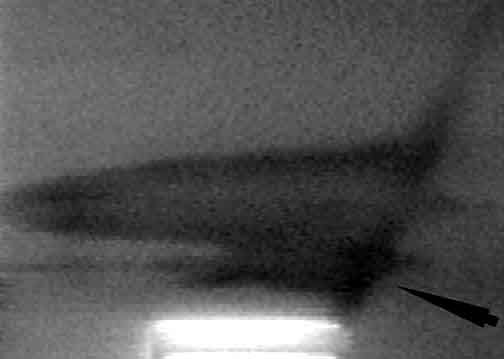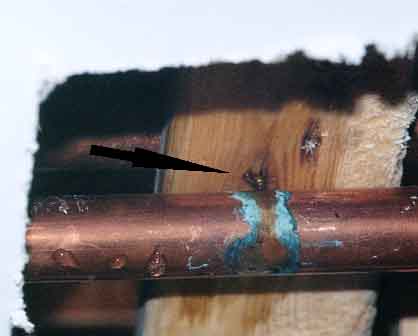THE ANATOMY OF WATER LEAKAGE
by
Charles C. Roberts, Jr.
Water leaks from plumbing in inaccessible areas can be difficult to
find. When the water leakage is sighted, it is tempting to conclude
that the point where the water is seen is the location of the leak.
This may or may not be true. Many times, water will travel
laterally above sheet rock and leak at a joint far from the source.

Figure 1

Figure 2

Figure 3
Figure 1 is a view of such a condition. The arrow on the right is the
location where water was found leaking from plumbing pipes in
the ceiling. The arrow on the left points to the actual leak in a
water pipe. Figure 2 is an infrared thermogram of the ceiling in the
vicinity of the leak. In the thermogram, lighter shades indicate
higher temperatures than shades of gray, which are colder
temperatures. The warm, bright thermal pattern from the ceiling
light is a reference with respect to Figure 1. The dark thermal
pattern on the ceiling is water in the ceiling sheet rock from the
leak and appears dark, or cold, due to evaporative cooling of the
water. It should be noted how the water pattern has spread out
laterally over the sheet rock and only appeared to be leaking at a
joint between pieces of sheet rock. The arrow points to the
location where water was observed leaking from the ceiling. Figure
3 is a thermogram showing the scene with the hot water turned on.
The light spot on the thermogram is hot water leaking from a pipe
in the ceiling.

Figure 4
Excavation at that site showed the leaking pipe in
Figure 4. Apparently a screw driven through a wood joist to
support another pipe contacted the outer diameter of the copper
water pipe, forming a partial penetration. Thermal cycling of the
pipe over the months caused failure of the pipe wall and eventual
water leakage. As with many water leaks, finding the source may
be difficult. Lateral movement of water may not be predictable,
leaving little clue as to the source. The leak can be intermittent as it
was in this case. The water only leaked when hot water traveled
through the pipe causing thermal movement and leakage. When the
water cooled from lack of use, the pipe would move into a position
where the screw sealed the leak. In this case, infrared
thermography was able to locate the source of the leak, minimizing
the time and ceiling damage that could have resulted from more
traditional means of locating the leak source.

Figure 5

Figure 6
Figure 5 is a view of joists and flooring near a leak in a copper
water pipe. The warped and deteriorated floor sheathing is evident
in the photograph. Figure 6 shows the water pipe with a corrosion
related pinhole that caused the water damage. The pinhole on top
of the pipe sprayed a fine stream of water directly at the wood
sheathing, showing little evidence of water leakage in the
crawlspace. The water moved horizontally throughout the
sheathing, badly damaging the floor, another example of water
damage far from the source.
The anatomy of a water leak is often complex since the source may
not be visible. Horizontal movement of water tends to obscure the
source. Instruments such as infrared cameras and ultrasonic testers
can help, but are not always successful in finding a leak.
FOR TECHNICAL ARTICLES CONTACT CLAIMS MAGAZINE AND ASK
FOR A REPRINT OF A PAST TECHNICAL NOTEBOOK ARTICLE
CLAIMS MAGAZINE





